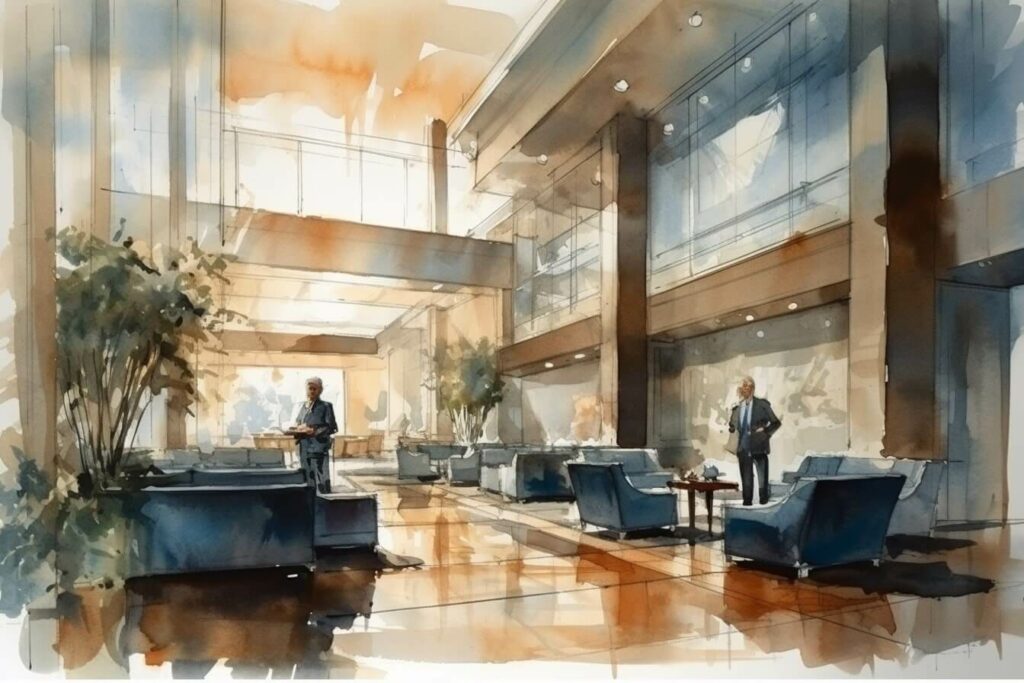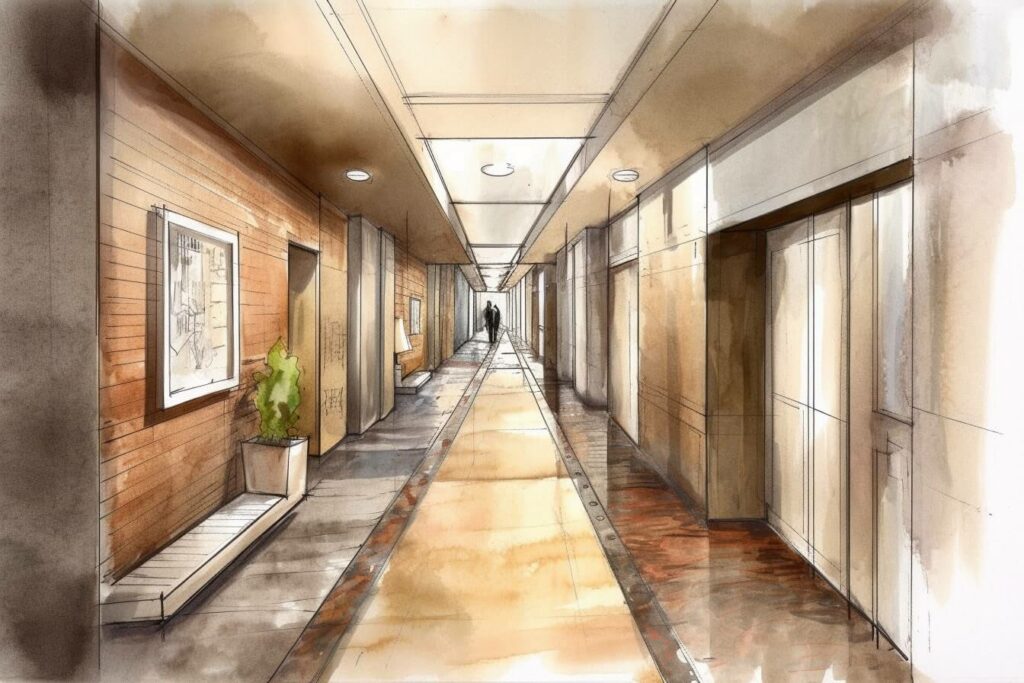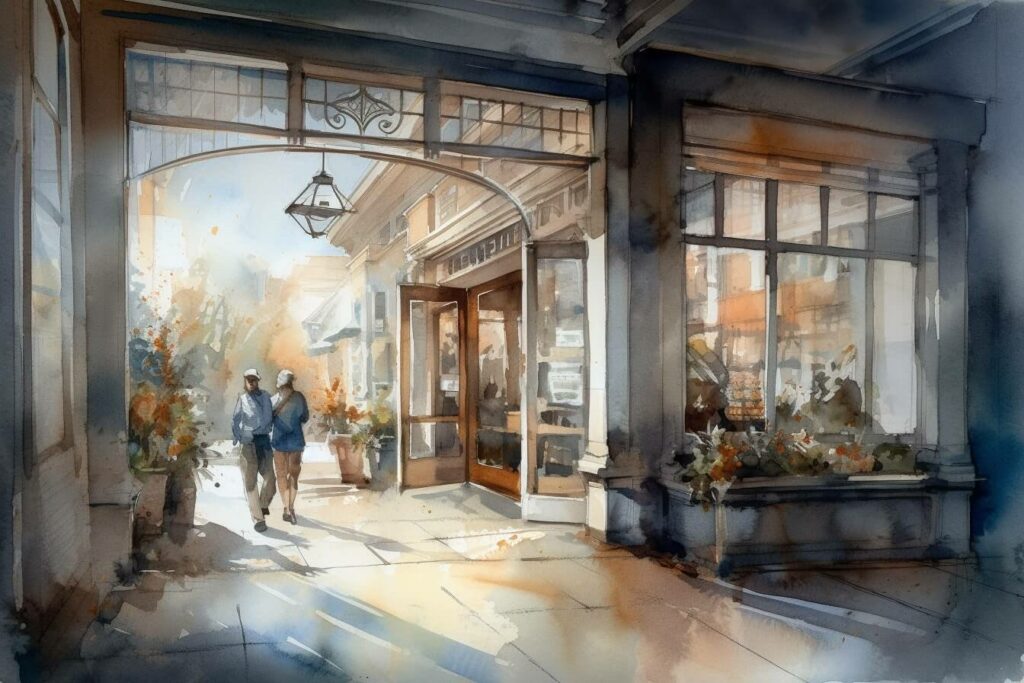
Master the Development of Sustainable Architectural ConceptS
START IN OCTOBER 7th
Introduction to Universal Design
Universal design is an innovative approach that focuses on creating environments and products accessible and usable by everyone, regardless of age, ability, or circumstance.
This concept has gained significant attention in recent years as architects, interior designers, and construction companies increasingly recognize the value of creating inclusive, adaptable, and future-proof spaces. But what exactly is universal design, and how does it impact the built environment?
In this article, we will explore the origins, principles, and applications of universal design and its implications for the future of architecture and design.
The core idea behind universal design is to create spaces that accommodate all users’ diverse needs and abilities rather than just a select few. This means considering the full spectrum of human experience, from young children and individuals with disabilities to older adults and those with temporary impairments. By prioritizing accessibility and inclusivity in the design process, the universal design aims to eliminate barriers, promote equal opportunities, and foster social integration.
Universal design transcends the traditional boundaries of architecture and interior design, encompassing various disciplines, including product design, urban planning, and digital design. By adopting a holistic and human-centered approach, universal design can transform how we live, work, and interact with our surroundings, ultimately contributing to a more inclusive and sustainable world.

A Brief History: Expanding the Origins of Universal Design
While the universal design may seem like a modern idea, its roots can be traced back to the 1970s. The movement began with architect Ron Mace, dedicated to barrier-free environments. Mace, a wheelchair user, understood firsthand the challenges faced by people with disabilities when navigating the built environment. His personal experiences fueled his passion for creating spaces that were accessible and usable by everyone.
In 1989, Mace founded the Center for Universal Design at North Carolina State University to further explore and promote universal design. The center brought together a multidisciplinary team of architects, designers, engineers, and researchers who collaboratively developed and refined universal design principles.
During the early 1990s, the team formulated the seven principles of universal design, which have since become the foundation of the movement. These principles were developed through extensive research, case studies, and consultation with experts in various fields, including architecture, interior design, occupational therapy, and disability rights advocacy.
The publication of the seven principles in 1997 marked a significant milestone in the universal design movement, as it provided a clear framework for designers and architects to create environments that were truly inclusive. The principles have since been widely adopted and adapted across various industries and disciplines, from product design to urban planning.
Since the establishment of the Center for Universal Design, the concept has continued to evolve, incorporating new technologies and responding to changing societal needs. Today, universal design has become an essential aspect of modern architecture and design, with an ever-growing number of professionals embracing its principles to create spaces that are accessible, functional, and aesthetically pleasing for all users.
The 7 Principles of Universal Design: A Closer Look
1. Equitable use
Equitable use refers to designing spaces and products that cater to diverse users without discrimination or segregation. This principle emphasizes the importance of inclusivity and aims to create environments that everyone can enjoy, regardless of their abilities, age, or background. Examples of equitable design include accessible entrances, adjustable countertops, and public spaces with seating options for individuals with various mobility needs.
2. Flexibility in use
Flexibility accommodates a wide range of preferences and abilities, allowing users to customize or adapt a space or product to suit their needs. This principle encourages designers to create adaptable and versatile solutions catering to different requirements. Examples include adjustable furniture, modular layouts, and appliances with customizable settings.
3. Simple and intuitive use
This principle emphasizes the need for designs that are easy to understand and use, regardless of the user’s experience, knowledge, language, or cognitive abilities. By prioritizing simplicity and intuitiveness, designers can create spaces and products that are user-friendly and efficient. Examples include clear signage, easy-to-navigate layouts, and user-friendly interfaces on devices or appliances.
4. Perceptible information
Perceptible information clearly communicates essential information, regardless of the user’s sensory abilities. This principle encourages designers to consider various methods of communication, such as visual, auditory, and tactile cues, to ensure that critical information is accessible to all users. Examples include tactile paving, high-contrast text, and audible announcements in public spaces.
5. Tolerance for error
Designing for tolerance for error involves minimizing hazards and adverse consequences of accidental or unintended actions. This principle aims to create environments that forgive user mistakes, helping reduce the risk of injury or frustration. Examples include slip-resistant flooring, rounded corners on furniture, and fail-safe mechanisms on appliances.
6. Low physical effort
Low physical effort focuses on designing spaces and products that can be used efficiently and comfortably with minimal physical exertion. This principle aims to create environments that are accessible and comfortable for all users, including those with limited strength, stamina, or dexterity. Examples include ergonomic furniture, lever-style door handles, and touchless faucets.
7. Size and space for approach and use
This principle emphasizes the need to provide appropriate space for reach, manipulation, and use, regardless of the user’s body size, posture, or mobility. By considering the spatial requirements of a diverse range of users, designers can create environments that are comfortable and accessible to everyone. Examples include ample turning space for wheelchair users, reachable shelves and cabinets, and knee clearance under countertops and desks.
The Importance of Universal Design
The Importance of Universal Design: Exploring Key Benefits
Accessibility for All
One of the primary goals of universal design is to create spaces and products that are accessible to everyone, including those with disabilities. By considering the needs of all users, the universal design aims to promote equal opportunities and social integration.
This approach fosters a more inclusive society where individuals with disabilities can participate fully in all aspects of life without facing unnecessary barriers. For example, ramps and elevators in public buildings can enable wheelchair users to access all areas, while adjustable workstations can accommodate employees with different physical abilities and preferences.
Aging in Place
As the global population ages, the demand for age-friendly environments is increasing. Universal design allows people to remain in their homes and communities for as long as possible by creating spaces that adapt to changing needs and abilities over time. Features such as zero-step entrances, bathroom grab bars, and adjustable-height countertops can facilitate daily activities and enhance safety for older adults.
By enabling aging in place, the universal design promotes independence, well-being, and a sense of belonging among older individuals, reducing the need for costly renovations or relocation to assisted living facilities.
Inclusivity in Public Spaces
Universal design ensures that public spaces, such as parks, transportation hubs, and cultural institutions, are welcoming and accessible to everyone. This promotes social interaction and enhances all users’ overall quality of life. Implementing universal design in public spaces can include accessible playground equipment, wide sidewalks with curb cuts, and tactile paving for visually impaired individuals.
Clear signage, easy-to-navigate layouts, and multi-sensory information displays can make public spaces more user-friendly and engaging for everyone, including those with cognitive or sensory impairments.
By fostering inclusivity in public spaces, the universal design contributes to developing vibrant, diverse communities where everyone can enjoy the benefits of social interaction, recreation, and cultural enrichment. Moreover, investing in universally designed public spaces can boost tourism and local economies, as these accessible environments cater to a broader range of visitors with varying needs and preferences.

Universal Design in Architecture: Exploring Residential and Commercial Applications
Residential Applications
In residential settings, universal design can be incorporated through various design elements catering to diverse users’ needs. These features not only benefit individuals with disabilities but also accommodate families with young children, aging adults, and those recovering from temporary injuries. Some key aspects of universal design in residential architecture include:
1. Zero-step entrances
By eliminating steps and providing a smooth, level entrance, zero-step entrances ensure easy access to homes for wheelchair users, people with mobility impairments, and those with strollers or wheeled luggage.
2. Wider doorways
Wider doorways allow for easier navigation throughout the home, especially for wheelchair users and individuals using walkers or other mobility aids. A minimum width of 32 inches is recommended to accommodate most mobility devices.
3. Accessible bathrooms
An accessible bathroom incorporates grab bars, roll-in showers, and raised toilet seats, making daily hygiene tasks safer and more comfortable for individuals with disabilities or limited mobility.
4. Adjustable countertops and cabinetry
Adjustable countertops and cabinetry can accommodate users of various heights and abilities in kitchens and bathrooms. Pull-down shelves, for example, can make items more accessible to wheelchair users or those with limited reach.
5. Open floor plans
Open floor plans provide flexibility and ease of movement, allowing for easier navigation and furniture rearrangement to suit the needs of different users.
Commercial Applications
For commercial buildings, universal design can be implemented through a range of features that ensure compliance with legal requirements and create welcoming environments for diverse customers. By embracing universal design principles, businesses can enhance overall customer experience and satisfaction. Key aspects of universal design in commercial architecture include:
1. Accessible entrances
Ensuring that commercial buildings have accessible entrances, such as ramps or automatic doors, makes them more welcoming to customers with disabilities or mobility impairments.
2. Ramps and elevators
Ramps and elevators provide essential vertical access within multi-story commercial buildings, allowing wheelchair users and others with mobility limitations to navigate the building easily.
3. Clear signage and wayfinding
Clear, high-contrast signage and intuitive wayfinding systems can help all customers navigate commercial spaces more easily, regardless of their visual, cognitive, or language abilities.
4. Accessible restrooms
Commercial buildings should include accessible restrooms with features such as grab bars, lowered sinks, and wide stalls to accommodate wheelchair users and those with other mobility impairments.
5. Flexible and adaptable spaces
Creating flexible and adaptable spaces within commercial buildings, such as conference rooms or retail stores, can accommodate various needs and preferences, making the space more inclusive and user-friendly.
By incorporating universal design principles in residential and commercial architecture, architects and builders can create environments that are functional and aesthetically pleasing and promote inclusivity, accessibility, and a higher quality of life for all users.

Master the Development of Sustainable Architectural ConceptS
START IN OCTOBER 7th
Universal Design in Interior Design: Delving into Furniture, Layout, Lighting, and Color Choices
Furniture and Layout
Universal design principles can be applied to furniture selection and layout to create adaptable, functional, and aesthetically pleasing spaces for a diverse range of users. Critical considerations for incorporating universal design in furniture and layout include:
1. Adaptable and multi-functional furniture
Choosing furniture that is adjustable, versatile, and serves multiple purposes can help cater to various needs and preferences. Examples include height-adjustable tables, chairs with adjustable armrests, and convertible sofas.
2. Clear pathways
Arranging furniture to create clear and unobstructed pathways can improve navigation and accessibility for all users, including those with mobility aids such as wheelchairs or walkers. This can be achieved by maintaining a minimum clearance of 36 inches between furniture pieces and avoiding clutter.
3. Reconfigurable spaces
Creating spaces that can be easily reconfigured or adapted to accommodate different needs and preferences ensures that the interior environment remains flexible and user-friendly. This can be achieved through modular furniture systems, movable partitions, and open floor plans.
Lighting and Color Choices
Lighting and color choices play critical roles in universal design. They can enhance visibility, contribute to a sense of well-being, and improve overall accessibility and comfort for all users. Critical aspects of universal design in lighting and color choices include:
1. Layered lighting
Implementing a layered approach that combines ambient, task, and accent lighting can help create a well-lit and comfortable environment for all users. This may involve using a mix of natural light, overhead fixtures, and task-specific lighting, such as under-cabinet lights in the kitchen or adjustable reading lamps in the bedroom.
2. Adaptive lighting
Incorporating adaptive lighting systems, such as dimmable lights and motion sensors, can help cater to individual preferences and ensure that lighting levels are appropriate for various tasks and activities.
3. Contrasting colors
Using contrasting colors to highlight essential elements, such as doorways, stair edges, or switches, can improve visibility and accessibility for individuals with visual impairments. High-contrast color schemes can also enhance the overall aesthetic appeal of the space, creating a visually engaging environment for all users.
4. Color psychology
Considering the psychological effects of color can contribute to a sense of well-being and comfort within the space. For example, using calming colors, such as blues and greens, in restful areas like bedrooms and employing energizing colors, such as reds and oranges, in functional spaces like kitchens and living rooms can create a more harmonious and user-friendly environment.
By thoughtfully applying universal design principles to furniture selection, layout, lighting, and color choices, interior designers can create spaces that are not only visually appealing and functional but also accessible, comfortable, and enjoyable for all users.
The Future of Universal Design: Embracing Smart Technologies and Sustainable Design
Smart Technologies
Integrating smart technologies into the universal design can further enhance accessibility and functionality, making spaces more adaptable and user-friendly for diverse users. Some examples of smart technologies that can be incorporated into the universal design include:
1. Voice-activated devices
Voice-activated devices, such as smart speakers and virtual assistants, can enable hands-free control of various home functions, making daily tasks easier for individuals with mobility or dexterity impairments.
2. Home automation systems
Home automation systems can be tailored to individual needs, allowing users to control lighting, temperature, security, and other aspects of their living environment through a single, easy-to-use interface. This can be particularly beneficial for individuals with cognitive or sensory impairments and older adults who may struggle with managing multiple devices.
3. Adaptive and personalized technology
Emerging technologies, such as artificial intelligence and machine learning, can be harnessed to create adaptive and personalized environments that cater to individual preferences and needs. For example, smart lighting systems could adjust automatically to a user’s preferred brightness level, while advanced home automation systems could learn users’ daily routines and adjust the environment accordingly.
Sustainable and Green Design
As the focus on sustainability and green design grows, universal design principles can be combined with eco-friendly practices to create spaces that are not only inclusive but also environmentally responsible. By adopting a holistic approach to design, architects, and designers can create spaces that benefit everyone, including future generations. Critical aspects of sustainable universal design include:
1. Energy efficiency
Incorporating energy-efficient technologies, such as LED lighting, high-performance windows, and energy-efficient appliances, can reduce the environmental impact of a space while also providing long-term cost savings for users.
2. Sustainable materials
Using sustainable materials, such as recycled or rapidly renewable resources, in construction and interior design can minimize the ecological footprint of space and contribute to a healthier indoor environment.
3. Water conservation
Integrating water-saving features, such as low-flow fixtures and rainwater harvesting systems, can help conserve valuable water resources while reducing user utility costs.
4. Indoor air quality
By prioritizing indoor air quality through the use of low-VOC paints and finishes, as well as incorporating natural ventilation and air filtration systems, universal design can promote a healthier living environment for all occupants.
By embracing smart technologies and sustainable design principles, the future of universal design holds the promise of creating spaces that are not only accessible and functional, environmentally responsible, and adaptable to the changing needs of a diverse range of users. This holistic approach to design can transform how we live, work, and interact with our built environment, fostering a more inclusive and sustainable world for all.

Conclusion: Embracing the Power of Universal Design for a More Inclusive and Sustainable Future
Universal design is a powerful and transformative approach that seeks to create spaces and products that are accessible, usable, and enjoyable for everyone, regardless of age, ability, or background. By considering the needs and abilities of diverse users, architects, interior designers, and construction companies can create environments that promote inclusivity, accessibility, and sustainability, ultimately enhancing the quality of life for all members of society.
As our world becomes increasingly interconnected and our society continues to evolve and become more diverse, the importance of universal design will only continue to grow. By embracing this philosophy, we can work together to create a more inclusive and equitable world where everyone has the opportunity to thrive and fully participate in daily life.
By adopting universal design principles in architecture, interior design, and product design, we can not only meet the immediate needs of individuals with disabilities, older adults, and those with temporary impairments but also anticipate and accommodate the changing needs of future generations. This forward-thinking approach ensures that our built environment remains adaptable and resilient in the face of global challenges, such as climate change and population aging.
Incorporating emerging technologies, like smart devices and home automation systems, alongside sustainable and green design practices further strengthens the impact of universal design, creating spaces that are both environmentally responsible and highly adaptable to the diverse needs of their users.
Ultimately, universal design is about recognizing and celebrating our shared humanity and designing environments that reflect the rich tapestry of human experience. By adopting and championing universal design, we can create a more inclusive and sustainable world, one space at a time.
Universal Design: Frequently Asked Questions
What is the primary goal of universal design?
The primary goal of universal design is to create spaces and products that are accessible, usable, and enjoyable for everyone, regardless of age, abilities, or background, promoting inclusivity and equal opportunities.
Who can benefit from universal design?
Everyone can benefit from universal design, including individuals with disabilities, older adults, families with young children, and those with temporary impairments or injuries.
How can universal design principles be applied in residential settings?
In residential settings, universal design can be incorporated through zero-step entrances, wider doorways, accessible bathrooms, adjustable countertops, and open floor plans.
What role does technology play in the future of universal design?
Integrating smart technologies, such as voice-activated devices and home automation systems, can further enhance the accessibility and functionality of universal design, making spaces more adaptable and user-friendly for a diverse range of users.
How can universal design and sustainability be combined?
Universal design principles can be combined with eco-friendly practices, such as energy efficiency, sustainable materials, water conservation, and indoor air quality, to create spaces that are not only inclusive but also environmentally responsible.

Master the Development of Sustainable Architectural ConceptS
START IN OCTOBER 7th
If you need our services in the Portuguese language, click here.